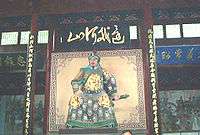Man Jiang Hong

Man Jiang Hong (simplified Chinese: 满江红; traditional Chinese: 滿江紅; pinyin: Mǎn Jīang Hóng; literally: "the whole river red") is the title of a set of Chinese lyrical poems (ci) sharing the same pattern. If unspecified, it most often refers to the one normally attributed to the Song dynasty general Yue Fei. However, the commonly accepted authorship of that particular poem has been disputed.
Poem and meaning
| Traditional Chinese | Simplified Chinese | Hanyu Pinyin | Translation |
|---|---|---|---|
| 怒髮衝冠,憑欄處,瀟瀟雨歇。 | 怒发冲冠,凭栏处,潇潇雨歇。 | nù fà chōng guān, píng lán chù, xiāo xiāo yǔ xiē. | My wrath bristles through my helmet, the rain stops as I stand by the rail; |
| 抬望眼,仰天長嘯,壯懷激烈。 | 抬望眼,仰天长啸,壮怀激烈。 | tái wàng yǎn, yǎng tiān cháng xiào, zhuàng huái jī liè. | I look up towards the sky and let loose a passionate roar. |
| 三十功名塵與土,八千里路雲和月。 | 三十功名尘与土,八千里路云和月。 | sān shí gōng míng chén yǔ tǔ, bā qiān lǐ lù yún hé yuè. | At the age of thirty, my deeds are nothing but dust, my journey has taken me over eight thousand li[notes 1] |
| 莫等閒白了少年頭,空悲切。 | 莫等闲白了少年头,空悲切。 | mò děng xián bái liǎo shào nián tóu, kōng bēi qiè. | So do not sit by idly, for young men will grow old in regret. |
| 靖康恥,猶未雪; | 靖康耻,犹未雪; | Jìng kāng chǐ, yóu wèi xuě; | The Humiliation of Jingkang[notes 2] still lingers, |
| 臣子恨,何時滅? | 臣子恨,何时灭? | chén zǐ hèn, hé shí miè? |
When will the pain of the Emperor's subjects ever end? |
| 駕長車踏破賀蘭山缺! | 驾长车踏破贺兰山缺! | jià cháng jū tà pò Hè lán shān què! | Let us ride our chariots through the Helan Pass, |
| 壯志飢餐胡虜肉,笑談渴飲匈奴血。 | 壮志饥餐胡虏肉,笑谈渴饮匈奴血。 | zhuàng zhì jī cān hú lǔ ròu, xiào tán kě yǐn xiōng nú xuè. | There we shall feast on barbarian flesh and drink the blood of the Xiongnu. |
| 待從頭收拾舊山河,朝天闕。 | 待从头收拾旧山河,朝天阙。 | daì cóng tóu shōu shí jiù shān hé, cháo tiān què. | Let us begin anew to recover our old empire,[notes 3] before paying tribute to the Emperor. |
Authorship controversy
The common belief is that Yue Fei wrote the poem in 1133 at the age of 30 during the Jin–Song Wars. In 1127, the Song emperors Qinzong and Huizong were captured by forces of the Jurchen-led Jin dynasty (this incident is known as the "Humiliation of Jingkang", as mentioned in the poem). Emperor Gaozong retreated to present-day Hangzhou in 1127 and established the Southern Song dynasty.
However, James T.C. Liu, a history professor from Princeton University, states that Yue Fei's version was actually written by a different person in the early 16th century.[1] The poem was not included in the collected works of Yue Fei compiled by Yue's grandson, Yue Ke (岳柯; 1183–post 1234), and neither was it mentioned in any major works written before the Ming dynasty. The section that states the author's wish "to stamp down Helan Pass" is what led scholars to this conclusion. Helan Pass was in Western Xia, which was not a military target of Yue Fei's armies. Liu suggests the "real author of the poem was probably Zhao Kuan who engraved it on a tablet at Yue Fei's tomb in 1502, in order to express the patriotic sentiments which were running high at that time, about four years after General Wang Yue scored a victory over the Oirats near the Helan Pass in Inner Mongolia."[1]
Song versions
Various song settings of the poem exist, including the traditional version from the 1930s recorded by operatic baritone Yi-Kwei Sze in the 1950s.
See also
Notes
- ↑ A li (ancient Chinese measurement of distance) is about half a kilometre or 1/3 of a mile.
- ↑ This refers to the Jingkang Incident of 1127, in which forces of the Jurchen-led Jin dynasty conquered the Northern Song dynasty's capital, Kaifeng, and captured the Song emperors Huizong and Qinzong.
- ↑ In 1141, the Song dynasty signed the humiliating Treaty of Shaoxing which renounced its claims to all lands north of the Huai River. In other words, the people of Song felt humiliated when they were forced to become a tributary of the Jurchens.
References
- 1 2 James T.C. Liu. "Yueh Fei (1103-41) and China's Heritage of Loyalty." The Journal of Asian Studies. Vol. 31, No. 2 (Feb., 1972), pp. 291-297